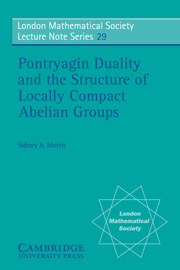Book contents
- Frontmatter
- Contents
- Preface
- 1 Introduction to topological groups
- 2 Subgroups and quotient groups of Rn
- 3 Uniform spaces and dual groups
- 4 Introduction to the Pontryagin-van Kampen duality theorem
- 5 Duality for compact and discrete groups
- 6 The duality theorem and the principal structure theorem
- 7 Consequences of the duality theorem
- 8 Locally Euclidean and NSS-groups
- 9 Non-abelian groups
- References
- Index of terms
- Index of Exercises, propositions and theorems
7 - Consequences of the duality theorem
Published online by Cambridge University Press: 11 November 2009
- Frontmatter
- Contents
- Preface
- 1 Introduction to topological groups
- 2 Subgroups and quotient groups of Rn
- 3 Uniform spaces and dual groups
- 4 Introduction to the Pontryagin-van Kampen duality theorem
- 5 Duality for compact and discrete groups
- 6 The duality theorem and the principal structure theorem
- 7 Consequences of the duality theorem
- 8 Locally Euclidean and NSS-groups
- 9 Non-abelian groups
- References
- Index of terms
- Index of Exercises, propositions and theorems
Summary
We begin this chapter by showing that the dual of a subgroup is a quotient group and the dual of a quotient group is a subgroup.
Definition. Let H be a closed subgroup of the LCA-group G and the set of all γ in the dual group Γ of G such that (h, γ) = 0, for all h ∈ H. Then ∧ is called the annihilator of H.
For fixed h ∈ H, the continuity of (h,γ) shows that the set of all γ with (h,γ) = 0 is closed, so that ∧ is the intersection of closed sets and is therefore closed. Clearly ∧ is a group and so it is a closed subgroup of Γ.
Proposition 38. With the above notation, if Γ is the annihilator of H, then H is the annihilator of ∧.
Proof. If h ∈ H, then (h,γ) =0 for all γ ∈ A. If g ∈ G and g ∉ H then, by Corollary 1 of Theorem 21, there is a γ ∈ ∧ such that (g,γ) ≠ 0. //
Theorem 27. Let H be a closed subgroup of an LCA-group G. If Γ is the dual group of G and Γ is the annihilator of H, ∧ then ∧ and Γ/∧ are topologically isomorphic to the dual groups of G/H and H, respectively.
Proof. Let f be the canonical homomorphism of G onto G/H. Then Proposition 30 says that the mapf*: (G\H)* → G* is a continuous one–one homomorphism.
- Type
- Chapter
- Information
- Publisher: Cambridge University PressPrint publication year: 1977



